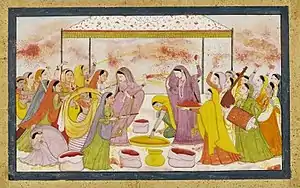Pahari painting
Pahari painting (literally meaning a painting from the mountainous regions: pahar means a mountain in Hindi) is an umbrella term used for a form of Indian painting, done mostly in miniature forms, originating from Himalayan hill kingdoms of North India, during 17th-19th century, notably Basohli, Mankot, Nurpur, Chamba, Kangra, Guler, Mandi, and Garhwal.[1][2] Nainsukh was a famous master of the mid-18th century, followed by his family workshop for another two generations.

Origin and area
The Pahari school developed and flourished during 17th-19th centuries stretching from Jammu to Almora and Garhwal, in the sub-Himalayan India, through Himachal Pradesh. Each created stark variations within the genre, ranging from bold intense Basohli Painting, originating from Basohli in Jammu and Kashmir, to the delicate and lyrical Kangra paintings, which became synonymous to the style before other schools of paintings developed. The Kangra style reached its pinnacle with paintings of Radha and Krishna, inspired by Jayadev's Gita Govinda.[3]
Pahari painting grew out of the Mughal painting, though this was patronized mostly by the Rajput kings who ruled many parts of the region, and gave birth to a new idiom in Indian painting.[4]
Schools of Pahari painting
Famous examples
Further reading
- Pahari Masters: Court Painters of Northern India by B. N. Goswamy and Eberhard Fischer Artibus Asiae. Supplementum, Vol. 38, Pahari Masters: Court Painters of Northern India (1992), pp. 3–391
- Wall Paintings of The Western Himalayas, by Mira Seth. Publications Division. 1976.
- Garhwal Paintings, by Mukandi Lal. Publications Division. 1982.
- Punjab Painting - Study in Art and Culture, by R P Srivastava. Abhinav Publications. 1983. ISBN 0-391-02560-0.
- Centres of Pahari Painting, by Chandramani Singh. Published by Abhinav Publications, 1982. ISBN 0-391-02412-4.
- Portfolio - The Bhagavata Paintings from Mankot, by Karl Khandalavala. Lalit Kala Akademi. 1981.
- On the origins of Pahari Painting, by Vishwa Chander Ohri, Joseph Jacobs. Indian Institute of Advanced Study. 1991. ISBN 81-85182-53-1.
- Nainsukh of Guler: A Great Indian Painter from a Small Hill-state by B.N. Goswamy. Niyogi Books. 2011. ISBN 978-81-89738-76-1
- Nala and Damayanti: A Great Series of Paintings of an Old Indian Romance. Niyogi Books. 1st Edition. 2015. ISBN 978-93-83098-89-7
References
- Hindu Hill Kingdoms Archived 30 March 2010 at the Wayback Machine V&A Museum.
- Pahari Kamat.
- Pahari centres Arts of India: Architecture, Sculpture, Painting, Music, Dance and Handicraft, by Krishna Chaitanya. Published by Abhinav Publications, 1987. ISBN 81-7017-209-8. Page 62.
- "Pahari". Archived from the original on 11 December 2009. Retrieved 28 May 2008.
- Pahari Paintings Archived 22 October 2007 at the Wayback Machine
- Pahari paintings
Further reading
- Kossak, Steven. (1997). Indian court painting, 16th-19th century. Metropolitan Museum of Art. ISBN 0870997831
External links
 Media related to Pahari painting at Wikimedia Commons
Media related to Pahari painting at Wikimedia Commons- Indian Court Painting, 16th-19th Century from the Metropolitan Museum of Art


